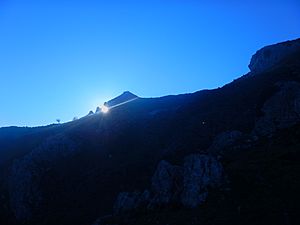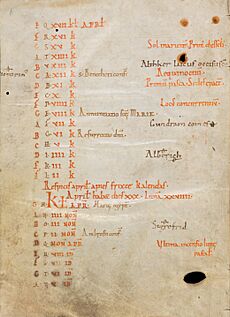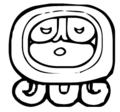History of calendars facts for kids
Have you ever wondered how people kept track of time before smartphones and digital clocks? The history of calendars is all about how humans, since ancient times, have found different ways to measure days, months, and years. Calendars are super important for daily life, culture, and even farming. They are often linked to studying the stars (astronomy) and growing crops (agriculture).
Scientists have found ways people kept time even before written history, going back to the Neolithic Age (New Stone Age). Early societies mostly used natural time units: the day, the solar year (how long it takes Earth to orbit the Sun), and the lunation (the time between new moons). The first official calendars appeared in the Bronze Age, around the same time people started writing.
For example, in Australia, a stone arrangement called Wurdi Youang might be over 11,000 years old. It could have been an ancient calendar! In Scotland, archaeologists found a 10,000-year-old calendar system at Warren Field. The Sumerian calendar came next, followed by calendars from ancient Egypt, Assyria, and Elam.
The Vikram Samvat is a calendar used by Hindus and Sikhs. It's one of several calendars in India. It uses 12 months based on the moon's cycles and 365 solar days. This calendar is named after a legendary king, Vikramaditya, and is believed to have started in 57 BC after his victory.
Many calendars from the ancient East, like those of the Persian Empire and the Hebrew calendar, were based on the Assyrian and Babylonian calendars.
Ancient calendars often combined moon and sun cycles (called lunisolar). They added extra months to keep the lunar year aligned with the solar year. This was usually done by watching the sky. Later, the Roman calendar was changed by Julius Caesar in 45 BC. His Julian calendar used a simple rule: add a leap day every four years. This meant the months no longer perfectly matched the moon's phases.
In the 11th century, a very accurate calendar reform happened in Persia, led by Omar Khayyam. The length of the year was measured with amazing precision! Today, the Gregorian calendar, introduced in 1582, is used almost everywhere for everyday life.
Contents
What Does "Calendar" Mean?
The word calendar comes from the Latin word calends. This was the name for the first day of the month in the Roman calendar. It's related to a Latin verb meaning "to call out," because the new moon was "called out" or announced. The Latin word calendarium also meant "account book," because people settled debts on the first day of each month.
The word came into English in the 13th century. The spelling calendar became common later, in the Early Modern English period.

Early Calendars: Prehistory
Many ancient structures might have been used to keep track of time, especially the solar year. This includes many huge stone structures (megaliths) from the Neolithic period.
- In Victoria, Australia, the Wurdi Youang stone arrangement could be over 11,000 years old. Its design matches how the Earth's orbit is thought to have changed over time.
- In Scotland, at Warren Field, archaeologists found a 10,000-year-old arrangement of twelve pits and an arc. It's thought to be a lunar calendar and was called the "world's oldest known calendar" in 2013.
- A clay object from Bulgaria, the Slatino furnace model, from around 5,000 BC, is claimed by some to be the oldest calendar representation.
- In Croatia, a ceramic pot from the Vučedol culture (2,600 BC) has symbols of stars. It's believed to be an ancient star calendar, showing the year starting at the beginning of spring.
Ancient Calendars: Near East
The ancient Sumerian calendar, from around 2,100 BC, divided the year into 12 lunar months. Each month had 29 or 30 days and started when the new moon was seen. To keep the lunar year (about 354 days) in line with the solar year (about 365 days), an extra month was added sometimes, like a leap year has an extra day. The Sumerian calendar didn't have weeks. Holidays were usually on the 1st, 7th, and 15th of each month, plus special feast days that changed from city to city.
Ancient Calendars: Beyond the Near East
Babylonia and Persia
The earliest signs of Iranian calendars are from the second millennium BC. However, the first complete calendar we know of is from the Achaemenid Empire. Persians have always cared a lot about calendars. They were among the first to use a solar calendar, which follows the sun, rather than lunar or lunisolar ones. The sun has always been an important symbol in Iranian culture.
Old Persian Calendar
Old Persian writings show that early Iranians used a 360-day calendar. It was based on observing the sun and adjusted for their beliefs. Days didn't have names. Months had two or three parts, depending on the moon's phase. There were 12 months of 30 days, named after festivals or farming activities. An extra 13th month was added every six years to keep the calendar in sync with the seasons.
Zoroastrian Calendar
The first calendars based on Zoroastrian beliefs appeared later in the Achaemenid period (650 to 330 BC). They changed over time, but the month names stayed mostly the same. The Achaemenid Empire needed its own calendar. So, they created one similar to the Egyptian style, with 12 months of 30 days. Each month was dedicated to a special being called a yazata.
Persian Calendar Changes
Later, the Parthians and then the Sasanids made small changes to this calendar. When the Sasanid king Ardashir I took power in AD 224, he made the Zoroastrian calendar official. This included fixing the timing of certain religious festivals (gahanbar) that had drifted out of sync with the seasons.
Modern Persian Calendar
In the 11th century, a major calendar reform happened in Persia. Malik-Shah, a ruler from 1073, invited the famous scientist Omar Khayyam to lead an observatory in Esfahan. For 18 years, Khayyam and other scientists worked there. They created new astronomical tables and reformed the calendar in 1079.
Khayyam calculated the length of the year as 365.24219858156 days. This was incredibly accurate! To compare, the length of the year was 365.242196 days at the end of the 19th century, and 365.242190 days at the end of the 20th century. This shows how amazing Khayyam's work was.
Classical Greece
The ancient Greeks, even in the time of Homer, knew about dividing the year into 12 lunar months. However, they didn't always mention extra months or days. Months were divided based on the moon's phases. The first day, or new moon, was called Noumenia. The month that started the year, and the names of the months, were different in various Greek states. Some places just numbered the months (first, second, etc.).
The Attic calendar of ancient Athens was a lunisolar calendar. It had 354-day years with 12 months that alternated between 29 and 30 days. To keep it aligned with the solar year (about 365.24 days), an extra month was added in certain years. The Athenian months had names like Hekatombion and Poseidon.
Besides their regular calendar, Athenians also had a political calendar. This calendar divided the year into "prytanies," one for each of the city's citizen groups. The number of these groups changed over time.
Ancient India
Keeping track of time was very important for ancient Vedic rituals in India. Jyotisha was the science of tracking stars and planets to set the correct dates and times for these rituals. This study developed around the end of the 2nd millennium BC. The oldest surviving text on Jyotisha is the Vedanga-Jyotisha.
The Brahma-siddhanta text, from the 5th century AD, explains how to use the movements of planets, the sun, and the moon to keep time and create calendars. It even includes complex math formulas to predict planetary positions. Ancient Hindu texts also mention water clocks and sundials.
The modern Hindu calendar, also called Panchanga, is a group of different lunisolar calendars used in Hinduism. They all use similar ideas for timekeeping but differ in how much they focus on the moon or sun, the names of months, and when the New Year starts. The ancient Hindu calendar is similar to the Jewish calendar in its design. Unlike the Gregorian calendar, which adds days to months, the Hindu calendar keeps the lunar month whole but adds an extra full month every few years. This ensures that festivals and farming rituals happen in the right season.
Hindu calendars have been used in India for a very long time. They are still used by Hindus in India and Nepal, especially for setting festival dates. Early Buddhist and Jain communities also adopted these calendars.
Roman Empire
The old Roman year had 304 days and 10 months, starting in March. However, the historian Livy said that an early Roman king, Numa Pompilius, created a 12-month calendar. The months Ianuarius (January) and Februarius (February) were added later.
Julius Caesar realized the Roman calendar system was not working well. So, in 45 BC, he made big changes. The New Year started on January 1st and had 365 days. Later, Augustus added the idea of the "leap year" in 4 AD. The resulting Julian calendar was used almost everywhere in Europe until 1582.
The Romans also used a system to number years based on the sitting consuls (leaders). For example, the year of Julius Caesar's third consulship was 708 AUC (or 46 BC). The seven-day week we use today also comes from the Roman Empire period.
Calendars in the Middle Ages
Christian Europe
The oldest list of saints' days for the Catholic Church was made in the mid-4th century. It included both pagan and Christian festivals. The oldest surviving Christian calendar manuscript is the Calendar of Filocalus from AD 354.
The Anno Domini (AD) system, which means "in the year of the Lord," was introduced in the 6th century. This system counts years from the supposed birth of Jesus. Before this, people often dated documents by the regnal years of kings or popes. The AD system slowly became common in Europe from the 11th to the 14th centuries. Portugal was the last Western European country to adopt it in 1422.

The Icelandic calendar was created in the 10th century. While older Germanic calendars used lunar months, the new Icelandic calendar was purely solar. It had a fixed number of weeks (52 weeks or 364 days). This meant they had to add "leap weeks" instead of leap days to keep it accurate.
Other ways of counting years existed in Christian Europe. In Spain, the "Era of the Caesars" started from Octavian's conquest of Spain in 39 BC. It was used in Spain and Portugal until the 14th and 15th centuries.
For Christians and Jews, an important historical date was the Year of Creation, or Annus Mundi (Year of the World). The Eastern Orthodox Church set the date of Creation at 5509 BC. The Coptic Church used 5500 BC. Later, in 1650, the Church of England's Archbishop Ussher calculated Creation to be in 4004 BC.
Islamic Calendar
The Islamic calendar is based on a rule by Muhammad that forbids adding extra months. This means it's a lunar calendar that shifts compared to the solar year and seasons.
During the Mughal rule in India, land taxes were collected using the Islamic Hijri calendar. But this lunar calendar didn't match the solar farming cycles. So, Mughal Emperor Akbar asked his astronomer to create a new calendar. This new calendar, called Fasholi shan (harvest calendar), combined the lunar Islamic calendar and the solar Hindu calendar. It was a blend of existing calendars.
Other Medieval Calendars
The ancient Taichu calendar of China was improved in the medieval period. The Dàmíng Calendar, created in the Liang dynasty, introduced the idea of equinoxes (when day and night are equal). The Yuan dynasty's Shòushí calendar (13th/14th century) used advanced math to find the length of the tropical year. This calendar had a 365.2425-day year, which is exactly the same as the Gregorian calendar!
African Calendars
Ethiopian Calendar
The Ge'ez or Ethiopian Calendar comes from the Ethiopian Empire. It's the religious calendar for Ethiopian and Eritrean Christians and is very similar to the Coptic calendar.
Nigerian Calendars
The Igbo calendar is the traditional calendar of the Igbo people in Nigeria. It has 13 months in a year, 7 weeks in a month, and 4 market days in a week. There's also an extra day at the end of the year. The Yoruba calendar is used by the Yoruba people of Nigeria and Benin. Its year starts around late May or early June of the Gregorian calendar, coinciding with the Ifá festival. The traditional Yoruba week has four days, each dedicated to a specific god (Orisa).
Ghana/West African Calendars
The Akan Calendar was created by the Akan people of West Africa. They used a traditional system based on a six-day week. When combined with the Gregorian seven-day week, this led to periods of 40 days, which they called adaduanan.
Xhosa Calendar
The traditional isiXhosa names for months in Southern Africa come from stars, plants, and seasonal changes. The Xhosa year traditionally starts in June and ends in May. This is when Canopus, the brightest star in the Southern Hemisphere, signals harvest time.
Mesoamerican Calendars
The calendars of the Maya and other Mesoamerican groups are some of the most complex ancient systems. The Mayan calendar had two main years:
- The 260-day Sacred Round, or tzolkin.
- The 365-day Vague Year, or haab.

The Sacred Round (260 days) combined two smaller cycles: numbers 1 to 13, and 20 different day names (like Imix, Ik, Ahau). This calendar was used for important religious and human activities, such as naming people, predicting the future, and choosing good dates for battles or weddings. The two cycles worked together and repeated without stopping. The cycle would end after 260 days.
The Vague Year (365 days) was similar to our modern Gregorian calendar. It had 18 months of 20 days each, plus an unlucky five-day period at the end. This year was mainly about seasons and farming, based on the solar cycle. The 18 Maya months had names like Pop, Uo, and Zip. The unlucky five-day period was called Uayeb, and it was seen as a time of danger and bad luck.
The Vague Year started with the month of Pop. The Maya 20-day month always began with the "seating" of the month, followed by days 1 to 19. Then came the "seating" of the next month. This showed the Maya belief that each month influenced the next. These two calendar cycles (the Sacred Round and the Vague Year) lined up every 52 years. This 52-year period was called a "bundle," like our modern century.
Modern Calendars
While the Gregorian calendar is now used worldwide for everyday purposes, many older calendars are still used for religious or cultural reasons. These include the Julian calendar, the Hebrew calendar, the Islamic calendar, various Hindu calendars, and the Zoroastrian calendar.
There are also some newer calendars that are used in a limited way. These might be for new religious groups, updated versions of old religious calendars, or calendars created by regional or nationalist movements.
- Javanese calendar (1633)
- Jōkyō calendar (1685)
- French Republican calendar (1793)
- Baháʼí calendar (1873)
- Solar Hijri calendar (1925)
- Pataphysical calendar (1949)
- Indian national calendar (1957)
- Discordian calendar (1963)
- Juche calendar (1997)
See also
- Names of the days of the week
- History of timekeeping devices
Images for kids



